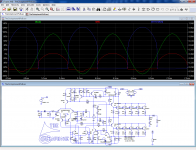At the local pharmacy? We pay 16 Euro for the IXFN132N50P3 (500V, 112A, 1.5kW), and it is 23 Euro at Mouser, both for single pieces.
Much cheaper than 5 laterals plus 5 ceramic insulators, and about the same as 5 HEXFETS on a copper plate spreader, but with zero matching problems, no soldering and no insulation needed.
The Monster Circlo is enough of a challenge in other areas, make your life easy where you can!
Much cheaper than 5 laterals plus 5 ceramic insulators, and about the same as 5 HEXFETS on a copper plate spreader, but with zero matching problems, no soldering and no insulation needed.
The Monster Circlo is enough of a challenge in other areas, make your life easy where you can!
But that's 11nF that only has to swing a few volts to turn the thing on and off, its simpler to calculate based on the total gate charge, and divide by the time that charge has to to flow.
100nC of charge that has to move in 15us needs on average about 7mA of drive.
Its not nearly as demanding as a switching application of a FET where you want that charge to flow in 50ns, needing 2A in this example.
100nC of charge that has to move in 15us needs on average about 7mA of drive.
Its not nearly as demanding as a switching application of a FET where you want that charge to flow in 50ns, needing 2A in this example.
These are all valid propositions, but one of the problems of a higher output power is the need for higher supply voltages.
The voltage across the active devices (not only the OP) will vary between ~1.5 and 150V, a 1:100 ratio, and because of the Early effect or its equivalent, this will shift the operating conditions to a point where the circlo engine runs out of steam.
Solutions could include a higher gain of the vertical loop, or systematic cascoding, but neither is very satisfactory.
At moderate to high supply voltages, the slope of the I-V characteristic remains manageable, but when the voltage swing approaches the Early voltage, the cumulative effect in the input, VAS, driver and output becomes too large, and the slope for all types of active devices is broadly comparable.
The voltage across the active devices (not only the OP) will vary between ~1.5 and 150V, a 1:100 ratio, and because of the Early effect or its equivalent, this will shift the operating conditions to a point where the circlo engine runs out of steam.
Solutions could include a higher gain of the vertical loop, or systematic cascoding, but neither is very satisfactory.
At moderate to high supply voltages, the slope of the I-V characteristic remains manageable, but when the voltage swing approaches the Early voltage, the cumulative effect in the input, VAS, driver and output becomes too large, and the slope for all types of active devices is broadly comparable.
I'm looking at IXTN40P50P (p channel).
It has over 11nF input capacitance, vs 2nF of regular hexfet.
How do you drive these monsters?
I get good result in simulation with IXTK200N10L2 (high power fet with wide SOA. Ciss is fairly high (23nF), but fairly constant if you can stay away from the 100 V limit (90V).
I'll wait for Elvee to give his feedback.
I just noticed that the unit price has gone up quit a bit (+/-23€/pc at Mouser)
Edwin
So based on your research so far, with current Circlophone design - what are the max rail voltages to work correctly, assuming the output devices and drivers are capable?These are all valid propositions, but one of the problems of a higher output power is the need for higher supply voltages.
Somewhere in the region of 100V, total supply: that's about the Early voltage of many usual transistors, in their spice model, at least.
I sampled some in reality, and the actual voltage is generally significantly higher, which means that a real amplifier could still be OK at >150V, but that's by no means guaranteed.
I'll continue thinking about it, and try to find an acceptable and deterministic solution
I sampled some in reality, and the actual voltage is generally significantly higher, which means that a real amplifier could still be OK at >150V, but that's by no means guaranteed.
I'll continue thinking about it, and try to find an acceptable and deterministic solution
- Status
- This old topic is closed. If you want to reopen this topic, contact a moderator using the "Report Post" button.
- Home
- Amplifiers
- Solid State
- High-Power Circlophone
